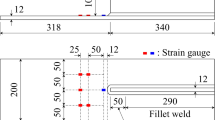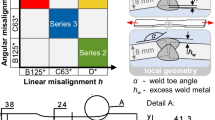Abstract
Fatigue resistance of high-frequency mechanical impact (HFMI) treatment is investigated on high-strength welded steel S690. Cyclic four-point bending tests are performed on butt weld samples and HFMI samples with different conditions of treatment with or without stress-relieving heat treatment. Microstructural characterisations with electron backscattering diffraction observations and residual stress analyses are presented. The main objective of this paper is to reveal and identify the parameters (residual stresses, geometry, strain hardening, etc.) which have an effect during the HFMI operation and to understand the phenomena involved during fatigue stressing. The optimisation of the geometry of the fatigue specimen allowed to repetitively obtain failures in the treated areas, thereby showing the relationship between the geometry, the strain hardening, the residual stresses and the fatigue strength. The main conclusions of this paper showed that HFMI treatment improves the fatigue performance of welded joints (in keeping with the International Institute of Welding results). The residual compressive stresses are prominent. The microstructure does not seem to have any effect, despite the nanostructured layer. The geometry is of secondary importance despite a significant change in the local geometry. HFMI treatment is also presented as retrofitting treatment.


















Similar content being viewed by others
References
Harrison JD (1966) Further techniques for improving the fatigue strength of welded joints. Br Weld J 13:642–647
G. Le Quilliec (2011) Application du martelage à haute fréquence à l’optimisation de la maintenance des ouvrages et des structures soudées. PhD thesis, École Centrale de Nantes - École Doctorale Sciences Pour l’Ingénieur Géosciences Architecture
Tehrani Yekta R, Ghahremani K, Walbridge S (2013) Effect of quality control parameter variations on the fatigue performance of ultrasonic impact treated welds. Int J Fatigue 55:245–256
Harati E, Svensson L-E, Karlsson L, Widmark M (2016) Effect of high frequency mechanical impact treatment on fatigue strength of welded 1300 MPa yield strength steel. Int J Fatigue 92(Part 1):96–106
K. Yamada, T. Kakiichi, T. Ishikawa (2009) Extending fatigue life of cracked welded joint by impact crack closure retrofit treatment, IIW Doc. XIII-2289r1-09, 2009, Fatigue Design
Y. Kudryavtsev, J. Kleiman, A. Lugovskoy, L. Lobanov, V. Knysh, O. Voitenko (2005) Rehabilitation and repair of welded elements and structures by ultrasonic peening, IIW Doc. XIII-2076-05
ISO 5817 Welding — Fusion-welded joints in steel, nickel, titanium and their alloys (beam welding excluded)—quality levels for imperfections
P. Gerster, F. Schäfers and M. Leitner (2013) Pneumatic impact treatment (PIT)—application and quality assurance. IIW Document XIII-WG2-138-13
P. Lefevre (2016) White paper, fatigue life improvement of welded structures by ultrasonic needle peening, Sonats
EN 15305 standard: Non-destructive testing. Test method for residual stress analysis by X-ray diffraction
M.F. Cipière, H.P. Lieurade, J.L. Lebrun (1989) Evaluation de l’endommagement par diffraction de rayons X. Rapport IRSID, mars
P. Mabelly, P. Hadmar, M. Desvignes, J.M. Sprauel (1996) Inflence des hétérogéneïtés de déformation élastique sur l’élargissement des pics de diffractionX. J. Phys III, Vol. 6
Etude de l’influence de l’intégrité de surface en tournage de l’acier 15-5PH sur la tenue en fatigue en flexion rotative (2014) PhD thesis, Vincent Chomienne
G. B. Marquis, Eeva Mikkola, Halid Can Yildirim and Zuheir Barsoum (2013) Fatigue strength improvement of steel structures by HFMI: proposed fatigue assessment guidelines. IIW Doc. XIII-2452-13
G. B. Marquis, Zuheir Barsoum (2013) A guideline for fatigue strength improvement of high-strength steel welded structures using high frequency mechanical impact treatment. Fatigue Design, Elsevier Procedia
Hobbacher A (2009) IIW recommendations for fatigue design of welded joints and components, WRC bulletin 520. The Welding Research Council, New York
Hanlon T, Kwon YN, Suresh S (2003) Grain size effects on the fatigue response of nanocrystalline metals. Scr Mater 49:665–680
Revilla-Gomez C, Buffiere J-Y, Verdu C, Peyrac C, Daflon L, Lefebvre F (2013) Assessment of the surface hardening effects from hammer peening on high strength steel. Procedia Engineering 66:150–160
M. Leitner, M. Stoschka, W. Eichlseder (2012) Contribution to the fatigue enhancement of thin walled high-strength steels using HFPT, IIW Doc, WG2
C. Peyrac, C. Combe, F. Lefebvre Fatigue strength improvement of high strength welded steel structures by hammer peening treatment, IIW-DOC XIII-2576-15
Acknowledgements
Authors would like to thank the contribution of the members of Cetim committee for their active participations.
Author information
Authors and Affiliations
Corresponding author
Additional information
Recommended for publication by Commission XIII - Fatigue of Welded Components and Structures
Rights and permissions
About this article
Cite this article
Lefebvre, F., Peyrac, C., Elbel, G. et al. HFMI: understanding the mechanisms for fatigue life improvement and repair of welded structures. Weld World 61, 789–799 (2017). https://doi.org/10.1007/s40194-017-0455-8
Received:
Accepted:
Published:
Issue Date:
DOI: https://doi.org/10.1007/s40194-017-0455-8




